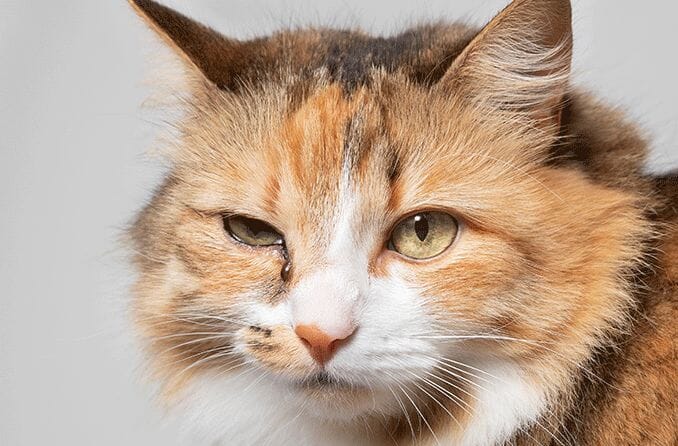Can Cats Get Pink Eye?
Conjunctivitis, commonly called pink eye is quite common in cats although many pet parents aren't very aware that cats can get pink eye. In fact, conjunctivitis is the most common feline eye disorder. Conjunctivitis is an inflammation of the mucus membrane covering the eyeball, the cat’s upper and lower eyelids and the lining of the eyelids.
Did you know that cats have a third eyelid in the inner corner of the eye? In healthy cats this eyelid is pale and not very visible. However, when a cat gets conjunctivitis, that membranes of the eye become red and swollen. Conjunctivitis can affect one or both eyes at the same time. Although pink eye doesn't usually last long, it is quite painful so it is important to diagnose it and take care of your cat's eyes as quickly as possible.
Since pink eye can have many causes, it is not an actual disease but rather a symptom of other feline eye infections. This makes it all the more important to diagnose properly. Cat of all breeds and all ages can be affected; however in young cats or kittens, conjunctivitis is often a sign of a cat cold complex virus. Taking good care of your kitty and trying measures to prevent conjunctivitis is a must. It is best to get conjunctivitis diagnosed as soon as possible because it can cause a lot of discomfort to the eyes.
Let's explore some more facts about conjunctivitis in cats, its causes, symptoms, and treatments.
Symptoms of Pink Eye (Conjunctivitis) in Cats
So how do you tell that a cat has pink eye?
Many of the symptoms of pink eye are fairly easy to spot if you just pay attention to your cat's eyes. Signs can range from mild redness around the eyes, swelling, discharge and more. Here are some other cat pink eye symptoms that you need to look out for:
- Excessive blinking and squinting.
- Your cat might find it difficult to keep their eyes open
- Watery, yellowish, green, or cloudy eyes
- Traces of bloody mucus around the eye
- The surrounding skin may lose hair
- Redness of the eyelid as well as around the eye
-
If your cat has infectious conjunctivitis, they may also display signs of an upper respiratory infection.
In such a case, the following are some more cat pink eye symptoms that you might notice in your cat:
- Runny nose (clear or thick mucus)
- Lethargy
- Decreased appetite
- Fever

What Causes Pink Eye in Cats?
The causes of pink eye in cats have been divided into two categories: infectious or non-infectious causes of conjunctivitis. Infectious causes are more common and are as follows:
Feline Herpesvirus Infection
Cat Herpes Virus has several names like FHV-1, feline viral rhinotracheitis, and feline calicivirus. Feline viral rhinotracheitis (FVR), is an infectious disease caused by the feline herpesvirus type-1 (FHV-1) is very species-specific and is only known to cause infections in domestic and wild cats. The virus can infect cats of all ages but is especially dangerous for kittens since their immune system isn't quite fully developed.
The virus is spread in saliva and in discharges from the eyes and nose of an infected cat which is why it is very important to keep infected cats separated from healthy cats in the household.
Stress in Cats
You may think your cat is living an ideal life, lazing about all day, but there is actually a lot that can be going on in a cat's life, like sudden changes when you introduce a new pet into the house, a new cat in the neighborhood, a change of food, new people in the house, loud fireworks on the 4th of July or celebrations outside, etc.
A cat may be a solitary, majestic creature who might not openly express their feelings, but their stress can affect them not only emotionally but physically. Physical signs of stress can include hair loss, itching, and a flare up of infectious conjunctivitis.
Compromised Immune System
A weaker immune system makes it harder for all cats, especially older cats and kittens to fight off infections. Cats with a compromised immune system are more prone to developing infectious diseases and also recovering quickly when they do get infects. For this reason, cats that are more susceptible should take an immune boosting supplement made specially for cats to help them fight off infections. It is also possible that your cat may develop an infection like pink eye due to regular use of steroidal medication or other underlying health issues.
Here are some non-infectious causes of pink eye in cats:
- Your cat may have caught some dirt in the eye. They may have come across toxic smoke or dust, or chemicals
- It may have been caused by an allergy flare-up, such as pollen.
- An eye injury of other cat eye infections
-Other health issues related to the eye can cause inflammation, such as tumors or eyelid abnormalities
Cat Conjunctivitis Treatment
The good news is that conjunctivitis can be treated. Your cat won't be uncomfortable and in pain for a long time and will recover with the right conjunctivitis remedy.
When you notice the signs of conjunctivitis in cats mentioned above, take your kitty to the doctor so that they can verify that your cat has conjunctivitis. Once the vet determines the cause of the eye infection they will begin the treatment by reducing the pain and eliminating the infection.
Typically, conjunctivitis in cats treatment involves giving a cat eye drops for relief. The vet may also suggest a topical solution to reduce inflammation and pain. Care is essential when using these medications to avoid further damage to the eye.
It is important that the cat does not scratch their eyes, causing the inflammation to flare and possibly leading to an eye ulcer. For this reason the vet may also recommend an Elizabeth collar.
The infected area must be kept clean. Any yucky eye gunk that forms around the eye can be removed using a warm cloth over a closed eyelid.

If you are looking for a natural eye infection treatment, and also one that does not involve fighting with your cat to administer eye drops in their eyes, consider the BestLife4Pets Eye Care Treatment for cats. The remedy comes in tiny, odorless and tasteless pills that are easy to give. The remedy is not a topical band-aid solution, but works on healing the cat's system from the inside out to get rid of the infection, reduce inflammation and clear up pink eye.
It is crucial to take care of your kitty during treatment. If the infection increases, your cat may develop an eye ulcer which can cause permanent damage. Chronic conjunctivitis in cats is a real struggle that can be the aftermath of an eye ulcer.
How to Prevent Pink Eye (Conjunctivitis) in Cats?
Regardless of how common conjunctivitis may be in cats is, it is essential to try and prevent it from happening. Here are a few things that you can do to prevent pink eye in cats:
Take Good Care of Their Health
Remember to clean a cat's eyes with a soft cloth when you bathe your pet. Ensure their ears, eye, and mouth are all clean to minimize the chances of developing an infection.
Feed cats nutritious food to boost and improve their immune system, and for compromised cats or young kittens, supplement with a good immunity boost cat supplement to strengthen their system. For all cats, be aware of situation that case them anxiety and try to reduce their stress.
For more tips on keeping your cat healthy no matter their age, check our our blog.
Keep Your Cat Away from Toxic Chemicals and Dust
Cats do as they please, but you can provide them with an environment that is safe for them to thrive. Ensure there are no foreign objects or dust around their living space. Use pet-friendly products in your home to keep your furry friends safe
Keep Infectious Pets Separated From Other Cats
As mentioned above, cat pink eye is highly contagious and your cat might spread the infection to other cats. Hence, you must keep the infected cat away from other pets in the house. Although not easy, prevention is always the better route so if you have sick pets in the house, especially other cats that have pink eye, keep them isolated until the infection clears. You must also take extra care and wash your hands whenever you interact with the furry little patient.
Frequently Asked Questions about Cat Pink Eye
Here are some more questions about conjunctivitis in cats that people frequently ask:
1. Can you get pink eye from a cat?
No, humans are not likely to catch feline conjunctivitis. However, the infection may transmit to another pet through you, for instance, by petting another cat after touching an infected one. Using the same tools, like a brush or food bowl, can also transmit the infection to an otherwise healthy cat.
2. Cat conjunctivitis won't go away
Typically, conjunctivitis in cats lasts for around 1 to 2 weeks. However, if symptoms persist, it may be because of an eye ulcer or chronic conjunctivitis, and your vet will help understand the cause of a persistent pink eye.
3. Can a cat's pink eye come back?
Yes, in the case of a non-infectious cause of conjunctivitis, the pink eye comes back until the real cause is treated.
4. What cat breeds are more likely to get pink eye?
Cat conjunctivitis breeds are nonexistent, and any cat from any breed can catch the infection at some point in their life. As mentioned above, senior cats and kittens are more likely to get pink eye because of their weaker immune system. The good news is that this can be helped. Shop the best health solutions for your pets at BestLife4Pets and keep them healthy and safe in your care.
Has your cat been having some trouble dropping the load? Read our blog for helpful tips to ease a cat's constipation.



